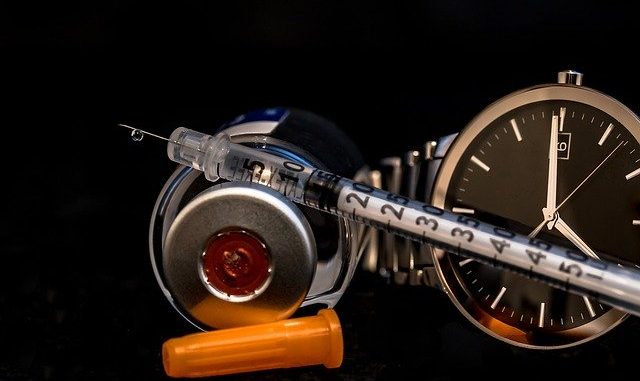
Insulin is a vital hormone for regulating blood glucose levels. It is critical for those with Type-1 diabetes because they do not produce the hormone. People with type-2 diabetes produce insulin but they have tissues which show a low or next-to-nothing response to the hormone. Insulin manufacture using gene technology or genetic engineering of bacteria is an important commercial industry to meet the need for insulin. Before gene technology was used, pig (porcine) insulin or cattle (bovine) insulin was used which brought in compatability issues.
The Structure Of Insulin
Insulin is a dipeptide but a relatively small and simple protein. It is made of 51 amino acids with 30 of these constituting the insulin chain B, and 21 amino acids making up a second chain called chain A. These two chains are linked by a disulphide bond.
What are the steps needed to engineer bacteria to synthesis human insulin?
Firstly (1), it is necessary to identify and then isolate the human insulin gene. There are a number of ways this is done but it often involves generating cDNA (copy DNA), a synthetic piece of DNA or a probe.
Next (2), the cDNA with the insulin producing genes is cut with restriction enzymes which are also termed restriction endonucleases.
(3) The cut gene is transferred to a bacterial plasmid. To achieve this, the plasmid is cut itself with a restriction endonuclease so that the foreign DNA can be inserted. Such plasmids usually carry an antibiotic-resistant gene so that these modified plasmids can be selected for later on. A DNA ligase catalyses the rejoining of the cut gene into the plasmid.
(4) The plasmid should now contain the human insulin gene which is then transferred to a bacterial cell using transformation.
(5) The bacteria is transformed.
(6) The bacteria containing the transformed plasmid can now use the antibiotic-resistance gene by growing the bacteria in the presence of the antibiotic.
(7) The bacteria is grown so that insulin is produce and released in larger, commercial amounts.
The Specific Method For Producing Insulin In E. coli Bacteria
The bacteria, E. coli is a common microorganism for genetic modification and gene engineering because it is simple to ferment and grow. It also has a straightforward gene structure. Genetic engineers make use of the lac operon which is used to manufacture the enzyme, beta-galactosidase.
The two chains of insulin are produced on two genes. These two genes are inserted into the lac operon of E.coli using a piece of cDNA. To aid copying of the two genes for insulin, methionine triplet start and stop codes are added to the cDNA for each of the insulin genes.
The E.coli bacteria are grown in the presence of lactose. As they multiply they release the insulin. The insulin protein is synthesized as a single chain but because there is a code for methionine separating the two chains (A & B) from each other, cyanogen bromide is used to cut the amino-acid sequence at the methionine amino-acid. The two chains A & B are released which then form the dipeptide using a chemical system to promote disulphide bridge formation.
Using Yeast Cells For Insulin Manufacture
In recent years, attention has turned to yeasts because they are eukaryotic and they too can be engineered to produce the insulin protein. Not only do yeasts have eukaryotic promoters but Golgi bodies too which means the insulin can be produced as a ready-made dipeptide with the correct 3-dimensional conformation. It means activity is optimal for use as a human hormone.
Isolation and Purification
Once a sufficient amount of insulin is produced, the cells are harvested, and the insulin is isolated and purified from the mixture of other proteins and cellular components.
Large-scale processes for purification of biosynthetic human insulin (BHI) are now based on reversed-phase high performance liquid chromatography (RP-HPLC) (Kroef et al., 1989).
What Are The Benefits Of using Gene Technology To Produce Human Insulin?
The human insulin produced by bacteria or yeast is identical to that of human insulin isolated from humans. There is virtually no issue with an immune response. It will also have a conformation which means it can interact effectively with human insulin receptors situated in the human cell surface membrane.
There is also no issue with tolerance to insulin as used to occur when cattle or pig insulin was used. The extraction of insulin from the pancreas of cattle and pigs was expensive.
Insulin Derivatives: Levemir
Levemir® is a classic example of a manufactured insulin produced by Novo Nordisk but to be discontinued in April 2024. It is a brand name for an insulin detemir which is a long-acting insulin that has been further modified following methods that are outlined above for producing recombinant human insulin.
Following isolation and purification, there is a unique chemical modification step followed-
- This modification involves the addition of fatty acid chains, notably by acylation with a 14-carbon fatty acid to the insulin molecule, which slows down its absorption and extends its duration of action in the body. This modification is crucial for Levemir’s status as a long-acting insulin.
- Formulation: The purified insulin detemir is then formulated into the final product. This may involve adding stabilizers, preservatives, and other excipients to ensure the stability and efficacy of the insulin.
- Insulin detemir is 98-99% albumin bound in plasma.
- Quality Control: Rigorous quality control measures are implemented throughout the manufacturing process to ensure the final product meets the required standards for safety, purity, and potency.
References
Kroef, E. P., Owens, R. A., Campbell, E. L., Johnson, R. D., & Marks, H. I. (1989). Production scale purification of biosynthetic human insulin by reversed-phase high-performance liquid chromatography. Journal of Chromatography A, 461, pp. 45-61
Leave a Reply